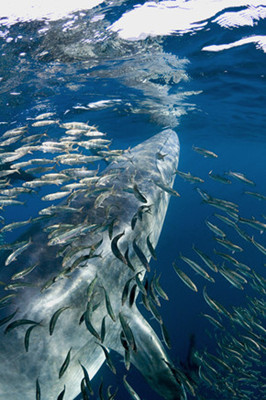魚類的價(jià)格
Different scales
不同種類有不同情況
Fish are getting more expensive, but they do not all move at the same speed
魚類的價(jià)格一路走高,然而上升的幅度卻各不相同。
Upwardly mobile
上浮的魚
IT IS a good time to be a fisherman. The global fish-price index of the UN's Food and Agricultural Organisation (FAO) hit a record high in May. Changing consumer diets, particularly in China, explain much of the sustained upward movement. High oil prices, which increase the cost of fishing and transportation, also add to the price of putting fish on the table.
這是個(gè)當(dāng)漁夫的好時(shí)代。聯(lián)合國糧農(nóng)組織的全球魚類價(jià)格指數(shù)在五月份創(chuàng)造了一個(gè)新的紀(jì)錄。消費(fèi)者們—尤其是中國的消費(fèi)者們—飲食習(xí)慣的改變,是魚價(jià)持續(xù)上漲的主要原因。此外,高昂的油價(jià)抬高了捕撈和運(yùn)輸成本,這些成本最后又被轉(zhuǎn)嫁到了餐桌上。

Not all fish are created equal, however. There are two types of fish production: “capture” (or wild) and “aquaculture” (or farmed). And they seem to be on different trajectories. Fish such as tuna, the majority of which is caught wild, saw much bigger price increases than salmon, which are easier to farm. Overall, the FAO's price index for wild fish nearly doubled between 1990 and 2012, whereas the one for farmed fish rose by only a fifth. What explains this big difference?
然而,魚的種類有許多,價(jià)格也參差不齊。魚的生產(chǎn)方式有兩種:捕撈野生魚和養(yǎng)殖家魚。兩者的價(jià)格趨勢(shì)不盡相同。相比如三文魚那樣容易養(yǎng)殖的魚種,金槍魚這些主要依靠捕撈的魚種的價(jià)格增長就要大得多。 從1990年到2012年,聯(lián)合國糧農(nóng)組織的野生魚類價(jià)格指數(shù)翻了一番,但家魚的價(jià)格指數(shù)只增長了五分之一。這種差別來自哪里呢?
The amount of wild fish captured globally has barely changed in the past two decades. The ceiling, of about 90m tonnes a year, seems to have been reached at the end of the 1980s. Overfishing is one reason, as is the limited room for productivity growth, particularly if consumers want high quality.
全球野生魚類的捕撈數(shù)量在過去二十年中幾乎沒有變化。在20世紀(jì)80年代末期,就已經(jīng)達(dá)到了9千萬噸的極限值。過渡捕撈是一個(gè)原因,另一個(gè)原因是產(chǎn)率增長的空間有限,尤其是在消費(fèi)者對(duì)質(zhì)量有很高要求的情況下。
Patrice Guillotreau of the University of Nantes tells the story of a fleet in France that decided to trawl, rather than line-catch, its tuna. It brought more back to shore, but the fish were damaged. It could not be sold as high-value fillets and was only good for canning. The old ways of catching fish are still best if you want the highest profits, says Mr Guillotreau.
南斯大學(xué)的Patrice Guillotreau講了這么一件事。法國的一個(gè)捕撈隊(duì)用拖網(wǎng)而不是釣繩垂釣的方式來捕撈金槍魚。這確實(shí)使產(chǎn)量增加了,但魚也受到了破壞,從而無法做成能賣出高價(jià)的條狀魚片而只能用來制作罐頭。Guillotreau說,想要保證魚能賣出最好的價(jià)錢,用傳統(tǒng)的方式來抓魚仍然是最好的選擇。
In contrast, the farmed-fish industry continues to make productivity improvements. Fish farms have found crafty ways to use lower quantities of fishmeal as feed. In the early days of aquaculture, it could take up to ten pounds of wild fish to produce one pound of salmon. Now the number is down to five. That may still be an inefficient use of protein, but the ratio is set to improve further. Fish farms have also become more energy-efficient, meaning that they are less affected by higher energy prices. And they have learned how to handle diseases better, reducing the quantity of fish that ends up being unsellable.
與之相反,家魚的產(chǎn)量卻不斷提高。魚養(yǎng)殖場(chǎng)已經(jīng)找到了節(jié)省魚飼料的竅門。在水產(chǎn)養(yǎng)殖業(yè)開展的初期,生產(chǎn)一磅大馬哈魚需要多達(dá)10磅的野魚當(dāng)飼料。現(xiàn)在這個(gè)數(shù)字已經(jīng)減少到了5磅。這樣養(yǎng)魚似乎仍然不是高效地利用蛋白質(zhì),但這個(gè)比率還有進(jìn)步的空間。現(xiàn)代的養(yǎng)殖場(chǎng)還十分節(jié)約能源,這減輕了能源價(jià)格上漲帶來的影響。而且他們學(xué)會(huì)了怎么控制魚類的疾病,從而減少了最后無法賣出的魚的數(shù)量。
As a result of all these improvements, the global production of farmed fish, measured in tonnes, now exceeds the production of beef. Output is likely to continue growing: the FAO estimates that by 2020 it will reach six times its 1990 level.
所有這些進(jìn)步使得全球家魚的產(chǎn)量如果以噸計(jì)算的話,已經(jīng)超過了牛肉的產(chǎn)量,而且還將繼續(xù)增長:據(jù)聯(lián)合國糧農(nóng)組織估計(jì),這一數(shù)字將在2020年時(shí)達(dá)到1990年的六倍。
This growth will further shake up the markets for fish. The farmed kind is expected to dominate the market for medium-value produce. Suppliers of wild fish, for their part, must slither into niche markets. At the low-value end wild sardine is a crucial input for farmed fish and is in abundant supply. More than a third of the total marine catch in 2010 was used for the production of fishmeal and fish oil.
這樣的增長還將造成魚市的重組。家魚將作為普通商品占據(jù)主要的市場(chǎng)份額。而野魚供應(yīng)商則逐漸占據(jù)高價(jià)市場(chǎng)。在市場(chǎng)的低價(jià)這一頭,則是野生沙丁魚。沙丁魚產(chǎn)量巨大,而且是家魚的一種主要飼料。2010年海洋捕撈總數(shù)的1/3以上都被用來制作魚飼料和魚油。
But more money may be made serving the captains of industry rather than industry itself. Sapmer, a French fishing company, recently discontinued its canned-tuna production, instead concentrating on catching tuna for sushi and sashimi for the top end of the market.
然而,服務(wù)其他行業(yè)的巨頭們似乎能比從事該行業(yè)本身得到更多的利益。法國漁業(yè)公司Sapmer最近就關(guān)閉了它的金槍魚罐頭生產(chǎn)線,轉(zhuǎn)而專心于捕撈金槍魚來為終端市場(chǎng)的壽司和生魚片提供原材料。
Frank Asche of the University of Stavanger, who helped to devise the FAO fish-price index, sees parallels with the divergence between farmed meat and wild game. As the supply of wild fish declines relative to farmed fish, it will become a luxury commodity, he explains. “In 20 years' time people will think of wild fish like we now think of venison.”
斯塔萬格大學(xué)的Frank Asche曾參與了聯(lián)合國糧農(nóng)組織魚價(jià)指數(shù)的設(shè)計(jì)。他認(rèn)為家魚和野魚的區(qū)別同飼養(yǎng)得到的肉類和狩獵捕獲的野味的區(qū)別類似。隨著野魚的數(shù)量和家魚相比逐年減少,它將成為一種昂貴的商品,他解釋說,“20年內(nèi)”人們就會(huì)像如今懷念山珍野味那樣懷念野魚的味道。翻譯 by 胡靚












